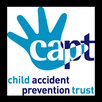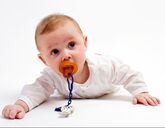You probably haven’t considered the risk to your child of strangulation but there are a growing number of children catching themselves, particularly on blind cords but drawstring bags, necklaces, cot bumpers and clothing also pose a risk.
So, how can strangulation be prevented?
Babies
Babies might not be able to move far, but they can reach and grab for things that catch their eye
Some babies have been strangled by looped cords hanging into their cot. This could be a string from a bag, or a blind cord, or a ribbon trailing into the cot. If you’ve got cot toys, make sure they’ve got short ribbons, and take them out of the cot when your baby goes to sleep. If there are cords nearby, like blind cords, make sure they are tied up high so that your baby can't reach them.
Dummy's
If your baby has a dummy (pacifier), the cord or string on the dummy can get looped around his neck. Although it might be annoying to keep retrieving lost dummies, having no cord on them is safer than tying them to your baby’s clothes. If you do still want to tie them to your baby's clothes, keep the ribbon shorter than 150mm to reduce the risk of strangulation.
Toddlers
Curious toddlers are especially vulnerable to strangulation because their heads weigh proportionately more than their bodies compared to adults and their muscle control isn’t fully developed, which makes it harder for them to free themselves if they get tangled up. Plus, their windpipes are smaller and less rigid than those of adults and older children. This means they suffocate far more quickly when their necks are constricted. In fact, it can take just 15 seconds for a toddler to lose consciousness if they get tangled in a blind cord. Death can occur in just two or three minutes.
Active and ready to explore having a toddler in your home means you need eyes in the back of your head! Take a moment to go around your home and think about what your toddler can reach and what they can climb on to get to things
Blind cords and chains
"Practising his newly-acquired climbing ability, a toddler climbs onto a chair. The chair is by a window with a roller blind and the blind cord is hanging near the chair. The child is unsteady, loses his footing and falls from the chair, tangling his head and neck in the looped blind cord....."
Keep blind cords tied up and out of your child’s reach!
Even if your cords or chains are well out of the way, your child might still reach them. If your toddler can scramble up on chairs, beds, cots and tables, make sure they are well out of the way of blind cords or chains and other hanging strings and loops.
NEVER cut a blind cord, as this will not only stop your blinds working, it can actually make your blinds more dangerous
You can also fit safety clips like those shown below:
NEVER cut a blind cord, as this will not only stop your blinds working, it can actually make your blinds more dangerous
You can also fit safety clips like those shown below:
Roller Blind Cord/Chain Safety Clips
While blind cords are a significant risk, there are lots of other common household items that could get caught around a your child's throat. To be dangerous it just needs to be long and flexible enough. Here is a list of things to be especially aware of:
- Suspended toys or mobiles above cots or beds
- Drawstrings on clothing
- Ropes or belts
- Drawstring bags (especially attached to where your child could get their head through the loop of the drawstring)
Remember – if your child can reach it they could strangle on it!
Strangulation Safety Tips
- Always clip blind cords right out of reach or use cordless blinds
- Never hang anything on the side of a cot or within reach of the child
- Small children should not wear necklaces or dummies round their necks
- Cot bumpers with ties should be avoided

P.S.
As I was searching and reading around for this post I was reminded of the work of the Child Accident Prevention Trust. Their website is a goldmine of excellent, age appropriate safety advice that I would urge all parents to take a look at!
https://www.capt.org.uk/capt-safety-advice
As I was searching and reading around for this post I was reminded of the work of the Child Accident Prevention Trust. Their website is a goldmine of excellent, age appropriate safety advice that I would urge all parents to take a look at!
https://www.capt.org.uk/capt-safety-advice
Written by Kate Ellwood First Aid Instructor (December 2019)
LifeFirst provides this information for guidance and it is not in any way a substitute for medical advice. LifeFirst is not responsible or liable for any diagnosis made, or actions taken based on this information. It is strongly advised that you attend a First Aid course to understand what to do in a medical emergency.
LifeFirst provides this information for guidance and it is not in any way a substitute for medical advice. LifeFirst is not responsible or liable for any diagnosis made, or actions taken based on this information. It is strongly advised that you attend a First Aid course to understand what to do in a medical emergency.





